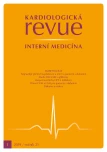Study DECLARE confirmed positive effect of dapagliflozin
Authors:
Špinar J. 1; Špinarová L. 2; Vítovec J. 2
Authors‘ workplace:
Lékařská fakulta MU Brno
1; I. interní kardioangiologická klinika LF MU a FN u sv. Anny v Brně
2
Published in:
Kardiol Rev Int Med 2019, 21(1): 7-12
Overview
SGLT2 – gliflozins are a new possibility of diabetes mellitus type 2 treatment. The mechanism of action is excretion of glucose by kidneys. The first mortality clinical trial with SGLT2 empagliflozin – EMPA-REG OUTCOME – was finished in 2015, and in the year 2017 the CANVAS programme with canagliflozin was published; other studies are ongoing. There is a large clinical programme for dapagliflozin, with smaller studies having shown a decrease in cardiovascular endpoints in a meta-analysis. DECLARE is an international clinical trial with dapagliflozin and the final results were presented at the congress of the American Heart Association in November 2018. The study included 17,160 patients with type 2 diabetes mellitus, who were randomised on placebo or dapagliflozin 10 mg/daily. The mean age was 63.8 + 6.8 years, mean duration of diabetes 11.8 + 7.8 years, mean glycated haemoglobin 8.3 +1.2 %. A total of 6,971 (40.6 %) were patients with confirmed cardiovascular disease, 10,189 (59.4 %) were patients with multiple risk factors. In the primary safety outcome analysis, dapagliflozin met the primary criterion for non-inferiority to placebo with respect to MACE (8.8 % dapagliflozin vs. 9.4 % placebo; p = 0.17). In the primary efficacy outcome, dapagliflozin did result in a lower rate of cardiovascular deaths or hospitalisation for heart failure (4.9 vs. 5.8 %). A renal event occurred in 4.3 % in the dapagliflozin group and in 5.6 % in the placebo group and death from any cause occurred in 6.2 and 6.6 % respectively. All the results prove the benefits of dapagliflozin.
Keywords:
gliflozins – dapagliflozin – DECLARE – hospitalisation for heart failure – mortality
Sources
1. Prázný M, Šoupal J. Postavení nových antidiabetik v klinické praxi: SGLT2 vs DPP4 inhibitory. Vnitř Lék 2015; 61(4): 291–294.
2. Zinman B, Wanner CH, Lachin JM et al. The EMPA-REG OUTCOME investigators. Empagliflozin, cardiovascular outcomes, and mortality in type 2 diabetes. N Engl J Med 2015; 373(22): 2117–2128. doi: 10.1056/ NEJMoa1504720.
3. Kvapil M. EMPA-REG OUTCOME. Důkaz, že populace pacientů s diabetem se mění. Remedia 2016; 26: 67–72.
4. Neal B, Perkovic P, Mahaffey KW et al. Canagliflozin and cardiovascular and renal events in type 2 diabetes. N Engl J Med 2017; 377(7): 644–657. doi: 10.1056/ NEJMoa1611925.
5. Raz I, Mosenzon O, Bonaca MP et al. DECLARE-TIMI 58: Participants baseline charcteristics. Diabetes Obes Metab 2018; 20(5): 1102–1110. doi: 10.1111/ dom.13217.
6. Špinar J. Dapagliflozin a studie DECLARE – vstupní charakteristika. Kardiol Rev Int Med 2018; 20(1): 61–65.
7. Wiviott SD, Raz M, Bonaca O et al. Dapagliflozin and cardiovascular outcomes in type 2 diabetes. N Engl J Med 2019; 380(4): 347–357. doi: 10.1056/ NEJMoa1812389.
8. Ferrannini E, Mark M, Mayoux E. CV Protection in the EMPA-REG outcome trial: A "Thrifty Substrate" hypothesis. Diabetes Care 2016; 39(7): 1108–1114. doi: 10.2337/ dc16-0330.
9. Mudaliar S, Alloju S, Henry RR. Can a shift in fuel energetics explain the beneficial cardiorenal outcomes in the EMPA-REG OUTCOME study? A unifying hypothesis. Diabetes Care 2016; 39(7): 1115–1122. doi: 10.2337/ dc16-0542.
10. Vallon V, Thomson SC. Targeting renal glucose reabsorption to treat hyperglycaemia: the pleiotropic effects of SGLT2 inhibition. Diabetologia 2017; 60(2): 215–225. doi: 10.1007/ s00125-016-4157-3.
11. Heerspink HJ, Perkins BA, Fitchett DH et al. Sodium Glucose cotransporter 2 inhibitors in the treatment of diabetes mellitus: cardiovascular and kidney effects, potential mechanisms, and clinical applications. Circulation 2016; 134(10): 752–772. doi: 10.1161/ CIRCULATIONAHA.116.021887.
12. Fletcher B, Gheorghe A, Moore D et al. Improving the recruitment activity of clinicians in randomised controlled trials: a systematic review. BMJ Open 2012; 2(1): e000496. doi: 10.1136/ bmjopen-2011-000496.
13. American diabetes asociation. 8. Pharmacologic approaches to glycemic treatment: standars of medical are in diabetes – 2018. Diabetes Care 2018; 41 (Suppl 1): S73–S85. doi: 10.2337/ dc18-S008.
14. American diabetes asociation. 8. Pharmacologic approaches to glycemic treatment: standars of medical are in diabetes – 2018. Diabetes Care 2018; 41 (Suppl 1): S86–S104. doi: 10.2337/ dc18-S009.
15. Ponikowski P, Voors AA, Anker SD et al. 2016 ESC Guidelines for the diagnosis and treatment of acute and chronic heart silure: The Task Force for the diagnosis and treatment of acute and chronic heart failure of the European Society of Cardiology (ESC). Eur Heart J 2016; 37(27):2129–2200. doi: 10.1093/ eurheartj/ ehw128.
16. Špinar J, Hradec J, Špinarová L et al. Souhrn Doporučených postupů ESC pro diagnostiku a léčbu akutního a chronického srdečního selhání z roku 2016. Připraven Českou kardiologickou společností. Cor Vasa 2016; 58(5): 597–636.
17. Verma S, Juni P, Mazer CD. Pump, pipes and filter: do SGLT2 inhibitors cover it all? Lancet 2019; 393(10166): 3–5. doi: 10.1016/ S0140-6736(18)32824-1.
18. Zelniker TA, Wiviot SD, Raz I et al. SGLT2 inhibitors for primary and secondary prevention of cardiovascular and renal outcomes in type 2 diabetes: a systematic review and meta-analysis of cardiovascular outocome trials. Lancet 2019; 393(10166): 31–39. doi: 10.1016/ S0140-6736(18)32590-x.
Labels
Paediatric cardiology Internal medicine Cardiac surgery CardiologyArticle was published in
Cardiology Review

2019 Issue 1
Most read in this issue
- Comparison of the benefits of FGM and CGM for different clinical scenarios in patients with type 1 diabetes mellitus
- The role of nebivolol in the treatment of cardiovascular diseases
- The most common causes of hospitalisation and death in patients with diabetes – results of the National Diabetology Registry
- Screening of asymptomatic carotid atherosclerosis in diabetic patients and its association with ankle-brachial index
